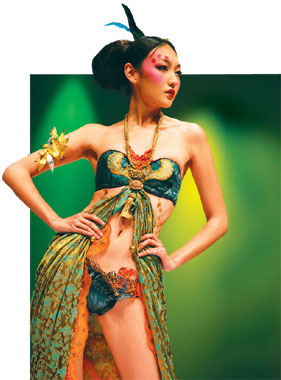
Thinking of lingerie and intimate apparel may evoke images of bras that hardly keep ladies covered and barely-there underwear.
Donning modern-day lingerie means putting everything on display and showing off a woman's shape in its most flattering way.
In ancient China, though, a curvy figure was considered a temptation and a sin, so women were left with few choices of outer clothes and were strictly governed by status. The underwear then became a unique channel for women to let out their romantic passion and over thousands of years, Chinese women developed various styles of underwear with amazing craftsmanship and ingenious designs.
To illustrate the use of old-time Chinese lingerie in today's world, a fashion design competition calling for inspiration from ancient Chinese lingerie elements was held by the China Fashion Association and Ordifen International Group.
Chinese water paintings, minority embroidery, Chinese red phoenix and cloud patterns, ceramics and Hanfu (the traditional dress of the Han Chinese) inspired ideas from about 800 designers from China, the UK and Japan.
Xie Lili, a young student from Guangxi, was the panel's unanimous choice for the gold prize with her original work Han Dynasty Beauty Feiyan. It celebrated the craftsmanship of the past alongside the natural form of the female and a perfect combination of blue gauze and flouncing with exquisite Miao handmade embroideries.
There were two runners-up. Fan Yuling adapted Hanfu elements like diagonal body-wrapping robes, diagonally crossing collars and hanging audit sleeves. Li Yingying's work related to ancient Chinese "Dudou" styles and highlighted the unique dancing phoenix patterns in ancient China.
Third place went to Taiwan designer Cai Peiying, who was inspired by the antique jade suit sewn with gold thread, which represented the highest level of craftsmanship in the Han Dynasty.
Other bronze prizewinners were Zhang Shengying, for her ancient, full-body garment design; and Hu Renjie, who blended classic Chinaware patterns into modern lingerie.
(China Daily December 30, 2008)